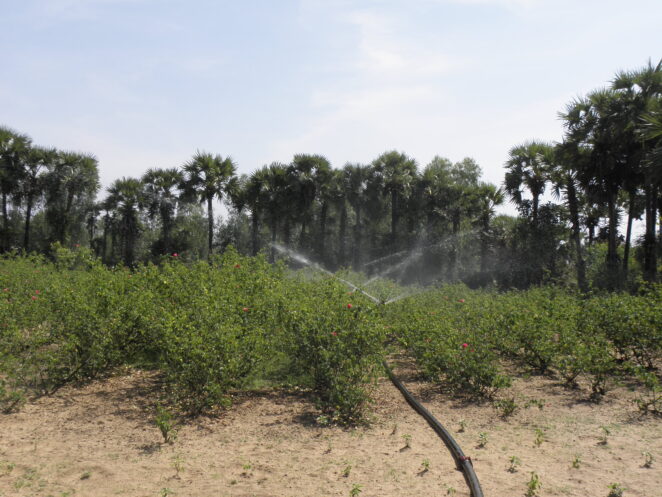Saving water and energy with an efficient irrigation system – Protecting agricultural livelihoods in the village of Poovula Doruvu, India


Poovula Doruvu’s sprinkling system
Poovula Doruvu is a village of 550 people located only 1 km from the coastline of the Bay of Bengal in Andhra Pradesh. The villagers earn their income primarily through cultivating groundnuts, flowers and vegetables. With rising temperatures and changing rainfall patterns already notable, however, problems for a proper irrigation increase. The flood irrigation technique applied in the village – small plots were irrigated using hand pumps and low-powered motors – required a lot of water and energy. Partly due to climate change the levels of rainwater and groundwater reserves are already decreasing. Water scarcity and an energy crisis led to low yields and insufficient income for the farmers already in the past, and uncertainties in water and energy supply are likely to increase with climate change in the future.
With the support of the EU-financed AdaptCap project, the community introduced an efficient irrigation scheme for the small horticulture and floriculture gardens in Poovula Doruvu. 35 sprinkler kits were distributed which can be shared by groups of three to four families each. The sprinkler kits consist of an electric pump, sprinkler sets including 26 pipes of 6 m length, quick action couplings, six sets of sprinkler couplers, sprinkler nozzles and riser pipes, as well as enough hose for about an acre of land.
The community already reported that this adaptation measure has been helpful in stabilizing and securing the irrigation of the existing fields while also enabling new fields to be watered. This measure has also made it possible to expand the crop base to include maize, gram, sweet potatoes and other crop plants. As a consequence, the productivity and income of the dependent families have increased and become stable. This adapation measure has led to:
- Saving water: Each sprinkler unit saves 13.44 m3 water per day. With 35 units running 200 working days a year, the pilot measure will save a total of 94,080 m3 water every year.
- Increase energy efficiency and save energy: One sprinkler unit saves 5 KWh energy per day. With the 35 units run expected to run for 200 working days, 35,000 KWh of energy are saved per year.
Implementation costs
The overall costs of this adaptation measure – including a local vulnerability and needs assessment, capacity building measures in the community, technical support as well as material and labour costs – amounted to Rs. 593,050. Of these, Rs. 516,050 were borne by AdaptCap while the community contributed Rs. 77,000.
Operation & maintenance of the system
In order to remain operative in the long run, several parts of the system require regular operation and maintenance (O&M). Regular O&M activities include:
- Periodical verification of the functioning of the motor
- Monitoring of the working condition of pipes and other accessories.
- Attending repairs and replacements
- Payment of electricity bill
The community has distributed the responsibilities and time frames for O&M activities among their members. The average monthly O&M costs amount to Rs. 400 and are fully covered by the community. As each sprinkler unit is used by two farming families, they can split their O&M costs (mostly for covering the electricity bill). Minor repair works are done by a trained operator in the village and are fee-based. Major repairs are done by the contracted suppliers themselves.
M&E of activities and benefits
A monitoring and evaluation (M&E) system was developed to regularly screen and assess the adaptation project’s sustainability and impact. Information is collected in four areas:
- Effectively achieved vulnerability reduction
- Acceptance by and technical feasibility for the community
- Cost for implementation and regular O&M
- Positive and negative side effects (i.e., environmental, social, economic)
Challenges and lessons learnt
- Ensure a strong buy-in and efficient and sustainable implementation through community participation during all phases of such an initiative.
- To ensure adaptation measure is accepted by the community, initially only 15 sprinkler units were distributed among the villagers. Another 20 units were provided thereafter by the contractor.
- It was not possible to supply the community with all 35 sprinkler units at the same time as frequent power cuts delayed them being manufacture.
- This adaptation measure is a low-technology solution and people were already familiar enough with the motors, pumps and sprinkler unit to handle them without any problems. All units work as the villagers expected them to, increasing the acceptance even more.
Project background and partners
The project “AdaptCap – Strengthening Adaptation Capacities and Minimizing Risks of Vulnerable Coastal Communities in India” financed by the European Commission has set out to strengthen the adaptation capacities of vulnerable coastal communities in Andhra Pradesh and Tamil Nadu (India) and minimize their climate change-related risks using an integrated approach.
The three-year initiative is implemented by the Indo-German Environment Partnership Programme of Deutsche Gesellschaft für Internationale Zusammenarbeit (GIZ-IGEP) in partnership with four Indian and international partners.
GIZ-IGEP is responsible for the overall implementation and project management.
Academy of Gandhian Studies (AGS) supports the stakeholders in three cities and nine villages in Andhra Pradesh as a local partner, providing training and implementation support in assessing adaptation needs and developing and carrying out adaptation measures.
AVVAI Village Welfare Society (AVVAI) fulfils the same role in Tamil Nadu.
adelphi contributed to developing technology solutions for the pilot projects and M&E frameworks, designing and implementing capacity building programmes and providing technical support for pilot project implementation.
ICLEI South Asia led the implementation of activities in the six urban areas targeted by AdaptCap.
(0) Comments
There is no content